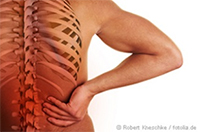How sitting affects the back

About five percent of all sick days are caused by back pain. "Unfortunately, the amount of time when we sit has overtaken the amount of time we move," says Jörg Bohmann, head of the Physiotherapy Center at the Medical Center - University of Freiburg. "This lack of exercise is one of the greatest health problems we face today." This is because long, slouched sitting negatively affects not just the joints and spine, but also the cardiovascular system, blood vessels, respiration, digestive system and mental well-being.
At the Medical Center - University of Freiburg, various departments deal with the treatment of back pain. Aside from the Physiotherapy Center, these include above all the Spinal Surgery Section and Sports Orthopedics and Traumatology Section - both in the Department of Orthopedics and Trauma Surgery - the Spinal Surgery ward in the Department of Neurosurgery, and the Interdisciplinary Pain Center.
Normally, the spine forms a double S-curve, much like a spring. It is suspended by muscles and ligaments, while intervertebral discs buffer and compensate for movement. The complex interaction of these structures enables simultaneous stability and flexibility. For this, the system must regularly be trained to move in a coordinated manner.
Why is sitting harmful?
By contrast, staying too long in one position is detrimental: whether upright in a standing position, bent over a desk or lying on a sofa does not matter. For example, someone who permanently sits slouched loses muscle power, and coordination with other parts of their body worsens. In addition, they less and less feel the need to move. The body gets used to slouched sitting, which is no longer perceived as harmful. "Then it becomes increasingly exhausting to return to an upright posture," says Bohmann.
Especially dangerous is when the spine in this abnormal position is burdened with acute, high pressure stress. "It is not uncommon for acute pain, or in some circumstances even a herniated disc, to occur while lifting heavy loads, sneezing, or straining on the toilet, when in a posture where the spine is not optimally aligned for such stress," says the Medical Center - University of Freiburg physiotherapist.
When to go to the doctor for back pain?
Not every backache needs to be diagnosed or treated by a doctor. How to assess the pain depends on its intensity and frequency, as well as how long the pain lasts.
It is important that those affected ask:
- Does the body tilt to one side when standing, is there a noticeable asymmetry?
- Does the pain radiate in the arms or legs?
- Is the pain associated with neurological changes such as tingling, numbness or atypical muscle weakness?
If one of these questions must be answered "yes", a doctor should be consulted immediately. In particular, neurological complaints should be clarified as quickly as possible.
What can be done about acute pain?
With acute pain, a vicious circle develops: "The pain leads to tension in the muscles, which in turn leads to an intensification of the pain," explains Bohmann. That is why, first of all, a painless position should be found. A combination of warmth and small, light movements can help release the tension. If the pain subsides, the person affected should slowly free themselves from the position, then go see a doctor or otherwise seek help.
What can I do myself about back pain?
Movement is the most important. "Anyone who does sports should take care not to burden themselves too one-sidedly," says Jörg Bohmann. Endurance, strength, mobility and coordination must be practised equally.
The physiotherapist also advises incorporating small challenges into everyday life: getting out of the lift one floor earlier than needed and taking the stairs, parking the car a few meters further away or even riding the bike. Exercises can also be integrated into the workplace. "Heavy and frequently used items should be placed on the shelf at chest height. But light things can be put way up high or down below. Then you have to stretch or actively bend each time," says Bohmann. "The spine needs to twist - so move. That's the best thing for us."
Back